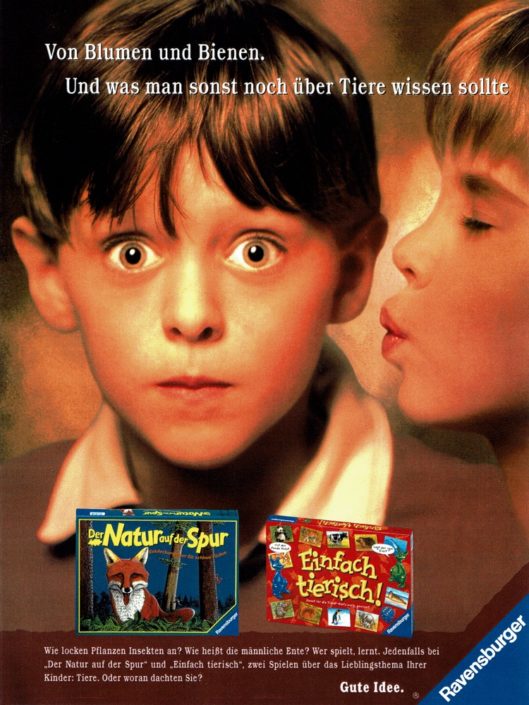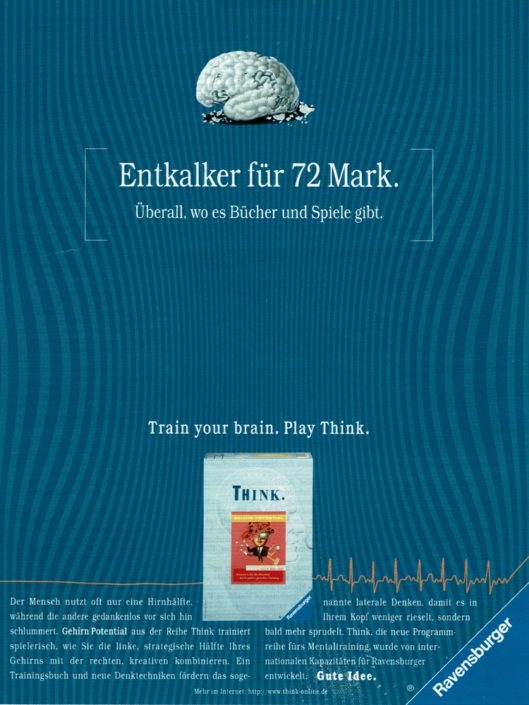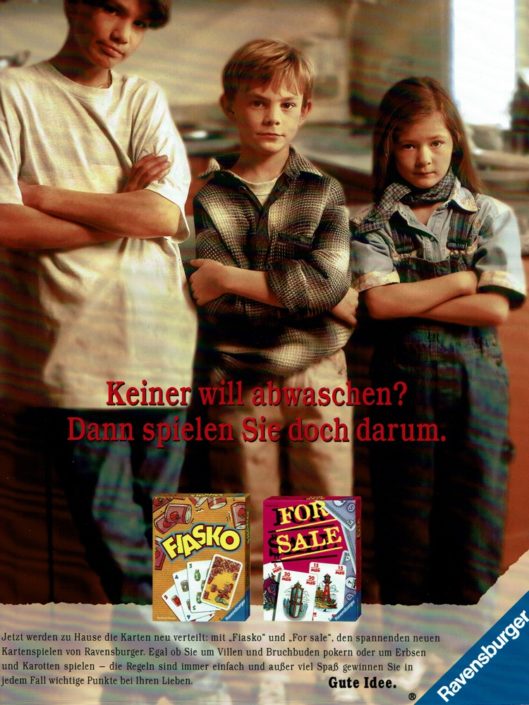REFRESH “RAVENSBURGER”
Brand & Product Management
BACKGROUND
The Ravensburger brand was a little bit outdated, somewhat “dusty” and stagnated in sales and market share. Although Ravensburger’s children’s games were seen as pedagogically valuable, they were rather “prescribed by mothers than wanted by children”. Children mostly demanded the entertaining, less demanding action games by Hasbro, MB and othes. The same applied to the painting & craft products, which focused on rather outdated classic handicraft themes for kids. The family games were mainly limited to the evergreens (Scotland Yard, Sagaland, Games Collection, etc.). Furthermore, Ravensburger was hardly represented in the adult target group, except for puzzles. However, puzzles were mostly dismissed by adults as “senior citizens’ entertainment”.
In order to generate sales and market share gains by updating and repositioning the Ravensburger brand and its products, I was called to the Ravensburger Spieleverlag.
STRATEGY
1. Updating the Brand
The baseline of the strategic development for the “brand refresh” was that any brand transformation had to also positively support all other divisions: the Ravensburger Buchverlag, Ravensburger Interactive and the Ravensburger Spieleland, since the sender was the same for all: “Ravensburger”.
- Children’s games, puzzles, painting & crafts: in a dual target group strategy both children and mothers were to be addressed, i.e. children want the Ravensburger products, mothers see the fun factor for their children in addition to the educational content and buy them – in short: “children want and demand, mothers buy”.
- Family games: activation of families “to play a Ravensburger game as a shared family experience more often”.
- Games for adults: activation and persuasion of adults that “Ravensburger is a relevant and interesting brand for an intelligent leisure activity”.
- Changing the perception of puzzles among adults, as a “meaningful, attractive activity for which there is nothing to be ashamed of”.
2. Updating Products & Categories
- In the direction of a “cool, child-friendly world of experiences”
- renaming of product categories
- a new contemporary design
- development of new games, crafts products, puzzle motifs and shapes as well as expansion of the adult product range through acquisitions (such as the acquisition of the company F.X. Schmid and the “launch of the “FX” brand)
EXCEUTION
1. Development of a new Brand Image & Claim
Historically, Ravensburger had never had an overarching brand claim until this point in time. The objective was to transform the brand from a rather educational brand to a brand with a world of experiences (with an educational basis). The claim should activate and have a challenging character based on the following consumer insight:
Everybody likes to play, tinker or do puzzles.
For perspective, leave an unfinished puzzle in a corner of your living room when you have friends over. Everybody will try the puzzle in an unnoticed moment. Or after an occasional board game, your friends will most likely remark: “That was fun. Why don’t we do it more often?”“
Out of this consumer insight and the thereof derived creative briefing, the brand claim was developed:
The brand claim is activating and challenging: “It’s a Good Idea (‘Gute Idee‘) to buy Ravensburger’s innovative and intelligent products and get involved with them.” It is comprehensive: it applies to the complete product range, whether games, puzzles, painting & crafts, books, CD-ROM games or a visit to the Ravensburger Spieleland.
As an anecdotal note: the penetration of the brand claim was so high, that as soon as you just introduced yourself or mentioned Ravensburger at the PoS, in a trade fair discussion, when visiting school classes or kindergarten, a “Good Idea” resounded to you.
2. Renaming, Product Development & Design
The product category Painting by Numbers was renamed “Kids Gallery”, the category Crafts “Creation”, the product design was modernized and new contemporary children’s learning (“First Learning”) and family games as well as Creation products (e.g. Charlotte, Pearl Animals) were developed.
The objective in product design, product development and communication was to achieve in all categories “the heroisation of the child” of whom the parents can be proud of, either because “it has made such a great end product” or because the child “won against the parents” in game. One of the prerequisites in product development in the Creation product category was that each product needed to be designed in such a way, that every child could achieve an extraordinary end result in a playful, simple way and with little manual skills.
In the adult area, new product series were created such as “THINK”, a mental training series, “Galerie” (Painting by Numbers for adults) and new puzzle motifs with the key benefit of “Relaxation”.
The THINK mental training series also satisfied the demand for innovative puzzle motifs and shapes for adults. For perspective, the THINK series included purely monochrome puzzle motifs (sic!) with unusual puzzle pieces (e.g. spiral pieces).
The print ads exemplify the new brand approach, the innovative product design and development as well as the new communicational focus.
Pls. find more print campaigns from Ravensburger and others >> here
3. Reorientation of the Communication Mix
In addition to a redesign of print ads and its content, new PoS measures (redesign of displays, introduction of “trail games” below the price threshold of € 5.00/10.00) and the first online activities (THINK website) were launched. However, the reorientation focused primarily on TV for the following reasons:
- Revenues of the Ravensburger Spieleverlag were mainly generated in the 4th quarter, specifically prior to Christmas. Therfore, the communication needed to work with high reach and frequency in order to create and achieve an immediate buying stimulus and thus the sales targets within a short period of time.
- Trading pressure (listing & overstocking) could only be achieved by TV support for lead products and product categories.
- Recharging the brand perception and its attributes made an advertising medium necessary that is able to induce the desired emotional impact.
- At last, a short-term “whining factor” (demanding children, buying mothers) can only be achieved with a fast-working advertising medium.
The focus on TV posed a new challenge, as I had to produce up to 10 commercials in a very short period of time and with limited budgets. This was solved as follows:
- Reducing fixed costs by shooting in tandem and up to 5 commercials in a week at one location.
- Reduction of variable costs by hiring young directors who do not yet have a significant showreel (e.g. graduates of the Film Academy Ludwigsburg).
The below commercials exemplify the new direction of the brand and product communication.









